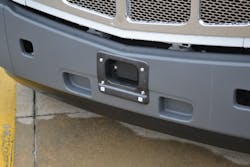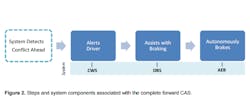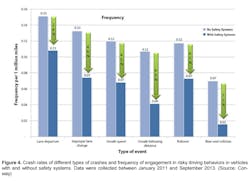Analysis: NTSB calls for collision avoidance tech, but will regulators mandate it?
Twenty years after calling for the adoption of collision warning technology, a new report by the National Transportation Safety Board outlines the life-saving benefits of currently available collision avoidance systems (CAS), and the watchdog agency recommends that the latest technology be made standard equipment on all new passenger and commercial vehicles.
In the Special Investigation Report, “The Use of Forward Collision Avoidance Systems to Prevent and Mitigate Rear-End Crashes,” NTSB admits that progress on a dozen related recommendations over two decades “has been very limited” and cites a lack of incentive and limited public awareness.
“The promise of a next generation of safety improvements has been used too often to justify inaction,” said Chairman Christopher A. Hart. "Because there will always be better technologies over the horizon, we must be careful to avoid letting perfection become the enemy of the good."
But progress has been significant and adoption actually is growing rapidly on the commercial vehicle side, especially in the Class 8 market.
The reason is simple: The technology works and makes good business sense for trucking, explains Alan Korn, director, vehicle dynamics and control at Meritor WABCO.
While the report—which Korn characterizes as an excellent summary of the issues—puts CAS market penetration at 8-10% in 2013, “it’s certainly higher today,” he noted. And though he was reluctant to speculate on the rate of adoption moving forward, Korn does estimate that market penetration could be near 20% for Class 8 highway tractors by the end of this year. The technology is also now being adopted in Class 5-7 trucks.
Indeed, while the report suggests the government agencies have been slow to come up with comprehensive standards to asses and test these systems—and which conceivably could stifle product development—suppliers have not let that interfere with innovation.
“You might read the report and think there’s not a lot going on, but there’s an incredible amount of activity in the marketplace,” Korn said. “Suppliers are coming out with new and improved systems and the interest is there because they’ve been found to be very, very effective.”
The upcoming iteration of Meritor WABCO’s collision mitigation technology, OnGuard Active, will add automatic braking on stationary objects to the radar-based object detection warning system, for example. That technology is directed at the one-third of truck crashes which involve stationary objects such as a vehicle stopped in the road, Korn adds.
So what does this mean, in terms of coming regulations or mandates?
Korn is quick to point out that while many of the related NTSB recommendations haven’t been adopted, it doesn’t mean they’ve been ignored by DOT agencies.
“It’s hard to predict what they’re going to do, but I think NHTSA is very interested in this technology,” he said, adding that CAS has already been included as a recommended technology in the light-vehicle NCAP, or New Car Assessment Program. So it’s possible NHTSA—fresh off of announcing a mandate for electronic stability control on heavy trucks—could issue a decision of intent to move forward, both for light and heavy vehicles, sometime this year.
And while Korn puts the likelihood at “fairly high” that the agency will begin the rulemaking process in the next couple of years, he also points out that any implementation would still be 2018 or 2019 at the earliest.
The report also touches on incentives for manufacturers and vehicle buyers, or the lack thereof—pointing out that the sooner CAS is widely adopted the sooner the number rear-end collisions will be reduced. For passenger vehicles, the report suggests adding more weight to the technology in NCAP.
For commercial vehicles, however, there is no NCAP system. But Korn points to FMCSA’s recent interest in the Beyond Compliance concept, or finding ways to reward carriers who voluntarily make the extra investment in safety systems.
“Obviously we would like to see an economic incentive—but that’s going to be very difficult,” he said. “Giving credit on CSA, however, is very doable. But the devil is in the details. How do we get fleets to at least try the technology? From our history, fleets that try the technology continue to buy the technology. How can we induce those fleets that are on the fence?”
Korn also notes that the trucks are often the vehicle being struck in read-end accidents, so the industry stands to benefit from wider adoption of CAS in passenger cars.
And he emphasizes that collision avoidance systems are designed to assist the driver in maintaining control of the vehicle and reducing the rear-end crash risk—but the driver remains “the overall pilot in charge” and remains responsible for the safe operation of the vehicle.
“We’re very supportive of the NTSB report,” Korn concluded. “Hopefully it will help motivate the industry to find ways—even before a mandate—to accelerate the deployment of these technologies.”
NTSB recommendations (with video)
In the report, the NTSB recommends that manufacturers make collision avoidance systems standard equipment in newly manufactured vehicles, beginning with collision warning systems, and adding autonomous emergency braking once NHTSA completes standards for such braking systems.
Furthermore, the NTSB recommends that NHTSA develop tests and standards in order to rate the performance of each vehicle’s collision avoidance systems and to incorporate those results into an expanded NCAP 5-star safety rating scale.
The NTSB is also issuing a companion Safety Alert for consumers and commercial fleet owners that urges them to consider vehicles with collision warning and autonomous emergency braking functions.
“You don’t pay extra for your seatbelt,” Chairman Hart said. “And you shouldn’t have to pay extra for technology that can help prevent a collision altogether.”
About the Author
Kevin Jones 1
Editor
Kevin has served as editor-in-chief of Trailer/Body Builders magazine since 2017—just the third editor in the magazine’s 60 years. He is also editorial director for Endeavor Business Media’s Commercial Vehicle group, which includes FleetOwner, Bulk Transporter, Refrigerated Transporter, American Trucker, and Fleet Maintenance magazines and websites.


